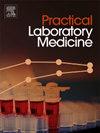The value of loop-mediated isothermal amplification in diagnosing lower respiratory tract infections in children
IF 1.7
Q3 MEDICAL LABORATORY TECHNOLOGY
引用次数: 0
Abstract
Objective
To evaluate the diagnostic value of loop-mediated isothermal amplification(LAMP) chip method (hereinafter referred to as "LAMP") in the detection of pathogens in children with lower respiratory tract infections(LRTIs).
Methods
Sputum samples from 1723 children with LRTIs hospitalized from April 2020 to April 2021 were collected. Pathogen detection was performed using both LAMP and sputum culture method(SCM).Detection rates and consistency between the two methods were analyzed using the Chi-square test and Kappa analysis.
Results
The positive detection rates of the LAMP and the SCM were 58.97 %(1016/1723) and 43.64 %(752/1723), respectively(P<0.001). The detection rates of Streptococcus pneumoniae (Spn)(24.26 %/13.52 %), Staphylococcus aureus(Sau)(13.12 %/10.39 %), Acinetobacter baumannii (Aba)(1.33 %/0.48 %), Stenotrophomonas maltophilia (Sma)(0.58 %/0.12 %), and Haemophilus influenzae(Hin)(31.05 %/16.19 %) were significantly higher with the LAMP than with the SCM(P<0.05). Both methods showed that single infections were predominant among children, with positive rates of 65.06 % and 87.23 %, respectively, with Hin(49.92 %/33.69 %) being the most common pathogen.In mixed infections, the positive rates were 34.94 % and 12.77 %, respectively, with mixed infections of Hin and Spn being the most common, accounting for 48.89 % and 32.29 % of cases, respectively. There were significant differences in the detection rates of Spn, Sau, Klebsiella pneumoniae(Kpn), Sma, Hin, and Escherichia coli(Eco) between single and mixed infections(P < 0.05). The detection results of Spn, Sau, Kpn, Hin, and Eco exhibited high consistency between the two methods, while the consistency for Pseudomonas aeruginosa(Pae), Aba, and Sma was lower.
Conclusion
The LAMP is simpler, faster, more sensitive and specific than SCM, offering a reliable laboratory diagnostic basis for clinical management of LRTIs in children.
目的 评价环介导等温扩增芯片法(LAMP)(以下简称 "LAMP")在下呼吸道感染(LRTI)患儿病原体检测中的诊断价值。方法 收集2020年4月至2021年4月期间住院的1723名LRTI患儿的痰标本。结果 LAMP 和 SCM 的阳性检出率分别为 58.97 %(1016/1723)和 43.64 %(752/1723)(P<0.001)。肺炎链球菌(Spn)(24.26 %/13.52 %)、金黄色葡萄球菌(Sau)(13.12 %/10.39 %)、鲍曼不动杆菌(Aba)(1.33 %/0.48 %)、嗜麦芽血单胞菌(Sma)(0.58 %/0.12 %)和流感嗜血杆菌(Hin)(31.05 %/16.19 %)。两种方法均显示,单一感染在儿童中占主导地位,阳性率分别为 65.06 % 和 87.23 %,其中 Hin(49.92 %/33.69 %)是最常见的病原体;在混合感染中,阳性率分别为 34.94 % 和 12.77 %,其中 Hin 和 Spn 混合感染最常见,分别占 48.89 % 和 32.29 %。Spn、Sau、肺炎克雷伯菌(Kpn)、Sma、Hin和大肠埃希菌(Eco)的检出率在单一感染和混合感染之间存在明显差异(P <0.05)。两种方法对 Spn、Sau、Kpn、Hin 和 Eco 的检测结果一致性较高,而对铜绿假单胞菌(Pae)、Aba 和 Sma 的检测结果一致性较低。
本文章由计算机程序翻译,如有差异,请以英文原文为准。
求助全文
约1分钟内获得全文
求助全文
来源期刊

Practical Laboratory Medicine
Health Professions-Radiological and Ultrasound Technology
CiteScore
3.50
自引率
0.00%
发文量
40
审稿时长
7 weeks
期刊介绍:
Practical Laboratory Medicine is a high-quality, peer-reviewed, international open-access journal publishing original research, new methods and critical evaluations, case reports and short papers in the fields of clinical chemistry and laboratory medicine. The objective of the journal is to provide practical information of immediate relevance to workers in clinical laboratories. The primary scope of the journal covers clinical chemistry, hematology, molecular biology and genetics relevant to laboratory medicine, microbiology, immunology, therapeutic drug monitoring and toxicology, laboratory management and informatics. We welcome papers which describe critical evaluations of biomarkers and their role in the diagnosis and treatment of clinically significant disease, validation of commercial and in-house IVD methods, method comparisons, interference reports, the development of new reagents and reference materials, reference range studies and regulatory compliance reports. Manuscripts describing the development of new methods applicable to laboratory medicine (including point-of-care testing) are particularly encouraged, even if preliminary or small scale.
 求助内容:
求助内容: 应助结果提醒方式:
应助结果提醒方式:


